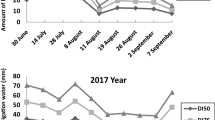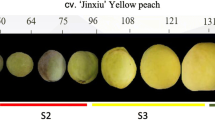Abstract
Olive (Olea europaea L.) is one of the most important crop plants grown in the Mediterranean region. Varying levels of hormones, sugars and mineral nutrient are thought to influence flower bud formation. The objective of this study was to evaluate the changes in endogenous sugar, mineral nutrition and hormone levels in leaf, node and fruit samples of ‘Memecik’ olive during the induction, initiation and differentiation periods in on (bearing) and off (non-bearing) years. Leaf, node and fruit samples of mature 15-year-old Memecik olive were used. The samples were taken during the induction, initiation and differentiation periods of olive in on (2000) and off (2001) years. Sugar (glucose, fructose and sucrose), mineral nutrient (N, P, K, Ca, Mg, Fe, Zn, Mn and Cu) and hormone [abscisic acid (ABA), indole acetic acid (IAA), gibberellic acid (GA3, GA4) and zeatin (Z)] levels were determined in on and off years. Hormone and sugar levels were measured by gas chromatography and high-performance liquid chromatography. The K, Ca, Mg, Fe, Mn, Zn and Cu levels were quantified by an atomic absorption spectrophotometry. Nitrogen was determined by the Kjeldahl procedure, and P by a spectrophotometric method. The differences in any of the sugar concentrations, with the exception of fructose, were not significant in on and off years. Hormone levels, however, were significantly different in on and off years. Glucose had the highest concentrations in both years, followed by sucrose and fructose, respectively. The highest macro and micro element concentrations were found to be Ca and Fe, respectively. Thus, the results suggest that carbohydrates and mineral nutrients may not have a direct effect to induce flower initiation. However, high GA3 level exhibited an inhibitory effect on floral formation during the induction and initiation periods. On the other hand, the high concentrations of GA4, ABA and certain cytokinin levels may have a positive effect on flower formation in olive during the induction and initiation periods.
Similar content being viewed by others
References
Ames I.H., Hill C.A., Walton D.C. and Dashek W.V. 1979. Hormonal regulation of genetic tumor induction: Cytokinin and abscisic acid. Plant Cell Physiol. 20: 1055–1061.
Bouat A. 1960. La Fumure de I'olivier-Fertilite-Paris Mai/Juin No: 13-25.
Bush D.S. and Jones R.L. 1998. Cytoplasmic calcium and a-amylase secretion from barley aleurone protoplasts. Eur. J. Biol. 46: 466–469.
Camara M.M., Diez C. and Tarija M.E. 1996. Free sugar determination by HPLC in pineapple products. Z. Lebensm. Unters. Forsch. 202: 233–237.
Chen W.S. 1987. Endogenous growth substances in relation to shoot growth and flower bud development of mango. J. Am. Soc. Hortic. Sci. 112: 360–363.
Chen W.S. 1990. Endogenous growth substance in xylem and shoot tip diffusate of lychee in relation to flowering. Hortic Sci. 25(3): 314–315.
Fahmi I. 1958. Changes in carbohydrate and nitrogen content in ''Souri'' olive leaves in relation to alternate bearing. Proc. Am. Soc. Hortic. Sci. 78: 252–256.
Forshey C.G. and Elfying D.C. 1989. The relationship between vegetative growth and fruiting in apple trees. Hortic. Rev. 11: 781–782.
Golomp A. and Goldschmidt F.F. 1981. Mineral balance of alternate bearing ''Wilking'' mandarins. Alon Hanotea 35: 639–647 (Hebrew).
Gur A. 1985. Rosaceae-deciduous fruit trees. In: Halevy A.H. (ed.) Handbook of Flowering, Vol 1, CRC Press, Boca Raton, pp. 355–389.
Hartmann H.T., Uriu K. and Lilleland O. 1966. Olive nutrition, Fruit nutrition, Horticultural Publications, Rutgers University, New Brunswick, New Jersey, pp. 252–261.
Kacar B. 1972. Chemical Analyses of Plant and Soil. II Bitki Analizleri. Agricul. Fac. Publications: 453, Aplication Guide: 155, Univ. Ankara, Ankara Basumevi, Ankara, pp. 646.
Lavee S., Haskal A. and Ben-Tal Y. 1983. Girdling olive trees, a partial solution to biennial bearing. I. Methods, timing and direct tree response. J. Hortic. Sci. 58: 209–218.
Lavee S. 1985. Olea europaea. In: Halevy A.H. (ed.), Hand Book of Flowering. Vol. III, CRC Press Inc., Boca Raton, Florida, pp. 423–434.
Lavee S. 1989. Involvement of plant growth regulators and endogenous growth substances in the control of alternate bearing. Acta Hortic. 239: 311–322.
Looney N.E., Pharis R.P. and Noma M. 1985. Promotion of flowering in apple trees with gibberellin A4 and A3 C-3 epigibberellin A4. Planta 165: 292–294.
Martin G.C., Connell J.H., Freeman M.W., Krueger W.H. and Sibbett G.S. 1994. Efficacy of foliar application of two naphthalenacetic acid salds for olive fruit thinning. Acta Hortic. 356: 302–305.
Monselise S.P. and Goldschmidt E.E. 1981. Alternate bearing in citrus and ways of control. Proc. Int. Soc. Citriculture 1: 239–242.
Mullins M.G. and Rajasekaran K. 1981. Fruiting cuttings: A revised method for producing test plants of grapevine cuttings. Amer. J. Enol. Vitic. 32: 35–40.
Olsen S.R. and Sommers E.L. 1982. Phosphorus. In: Page A.L., Miller R.H. and Keeney D.R. (eds), Methods of Soil Analysis. Part 2. Chemical and microbiological properties-Agronomy Monograph No. 9 (2nd ed.), Wisconsin, USA, pp. 403-430.
Pal S. and Ram S. 1978. Endogenous gibberellins of mango shoot-tips and their significance in flowering. Sci. Hortic. 9: 369–379.
Prakash L. and Prathapasenan G. 1990. NaCl and gibberellic acid-induced changes in the content of auxin and the activities of cellulase and pectin lyase during leaf growth in rice (Oryza sativa). Ann. Bot. 65: 251–257.
Priestly G.A. 1977. The annual turnover resources in young olive trees. J. Hortic. Sci. 52: 105–112.
Ramirez H. and Hoad G.V. 1981. Effects of growth substances on fruit-bud initiation in apple. Acta Hortic. 120: 131–136.
Sarmiento R., Valpuestra V., Catalina L. and Gonzoles-Garcia F. 1976. Variation of the contents of starch and soluble carbohydrate of leaves and buds of plants of Olea europaea var. Manzanillo in relation to their vegetative or reproductive process. Aneles de Edafologia y Agrobiologia 35: 683–695.
Schlenk H. and Gellerman J.L. 1960. Esterification of fatty acids with diazomethane on a small scale. Anal. Chem. 32: 1412–1414.
Shimizu T., Torikata H. and Torii S. 1978. Studies on the effect of crop load on the composition of satsuma mandarin trees. V. Analysis of production process of bearing and non bearing trees based on the carbohydrate economy. J. Jap. Soc. Hort. Sci. 46: 465–478.
Staden J.V. and Nicholson R.I.D. 1989. Cytokinins and mango flower malformation. II. The cytokinin complement produced by Fusarium moniliforme and the ability of the fungus to incorporate (8-14C) adenine into cytokinins. Physiol. Mol. Plant Pathol. 35: 423–431.
Stephan M., Bangerth F. and Schneider G. 1999. Quantification of endogenous gibberellins in exudates from fruits of Malus domestica. Plant Growth Regul. 28: 55–58.
Stutte G.W. and Martin G.C. 1986. Effect of light intensity and carbohydrate reserves on flowering in olive. J. Am. Hortic. Sci. 11(1): 27–31.
Topçu?olu F. and Unyayar S. 1995. Determination of growth substances (Auxin, gibberellic acid, abscisic acidandcytokinin) production and biological activity in white rot fungus Phanerochate chrysosporium ME 446. ?nönü Univ., Ara? tirma Fonu Proje No; ?.Ñ.A.F. Malatya, pp. 93–119.
Ulger S., Baktur I. and ve Kaynak L. 1999. Determination of the effects of endogenous plant hormones on alternate bearing and flower bud formation. Turk. J. Agric. For. 23(3): 519–523.
Weiler E.W., Jourdan P.S. and Conrad W. 1981. Levels of indole-3-acetic acid in intact and decapitated coleoptiles as determined by a specific and highly sensitive solid-phase enzyme immunoassay. Planta 153: 561–571.
Zieslin N. and Geller Z. 1983. Studies with Liatris spicata Willd. 1. Effect of temperature on sprouting, flowering and gibberellin content. Ann. Bot. 52: 849–853.
Author information
Authors and Affiliations
Rights and permissions
About this article
Cite this article
Ulger, S., Sonmez, S., Karkacier, M. et al. Determination of endogenous hormones, sugars and mineral nutrition levels during the induction, initiation and differentiation stage and their effects on flower formation in olive. Plant Growth Regulation 42, 89–95 (2004). https://doi.org/10.1023/B:GROW.0000014897.22172.7d
Issue Date:
DOI: https://doi.org/10.1023/B:GROW.0000014897.22172.7d




